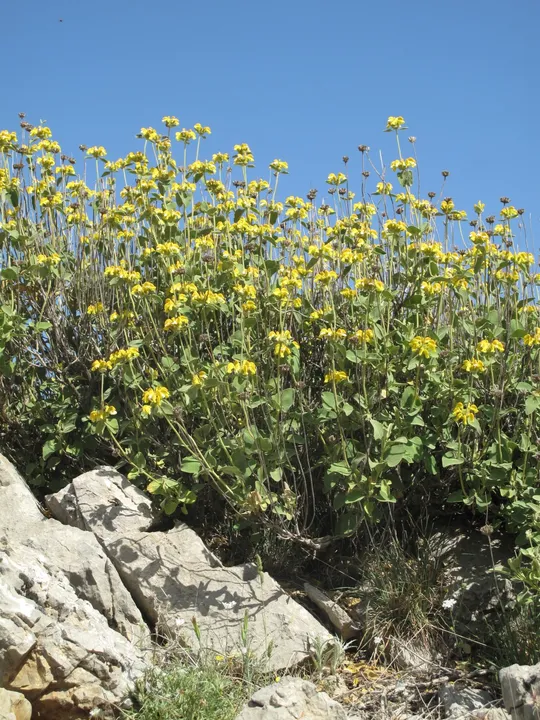Gold-leafed Phlomis, Goldleaf Jerusalem Sage
Phlomis chrysophylla




Phlomis chrysophylla grows in Israel
only in the Upper Galilee, at a single site in the Wadi Kadesh canyon, near the large waterfall, where the main
concentration was found on an area of about
5 hectares. Individual specimens also grow downstream and on the lower slopes.
The Flora of Post noted the plant from the Judean Mountains as well, where it
was collected at the end of the 19th century "between Hebron to Zawit
el-Fauqa". Attempts to locate the species in Gush Etzion and in the southern
Hebron Mountains were unsuccessful. However, north of Kfar Etzion and on Mount Meron
there are specimens of P. viscosa with few glandular hairs and leaf color similar
to P. chrysophylla. Its other features are similar to
the P. viscosa. P.
chrysophylla is
common on Mount Hermon, where there is distinct zoning between P.
viscosa that grows in
the Mediterranean zone at an altitude of 200-1200 meters and P.
chrysophylla that replaces
it in the montane zone. On Mount Dov, at altitudes of 1100-1300 meters hybrids
were found.
In Israel –
boulders and rocks on rocky ledges or cliffs in exposed areas or in open woodland
on hard limestone at altitudes of 200-400 meters. In Wadi Kadesh Phlomis chrysophylla grows on very steep rocky slopes, on both sides of the wadi, in
the midst of woodland vegetation of Quercus calliprinos, Pistacia
palaestina, P. atlantica and Amygdalus korschinskii. On Mount Hermon it grows on rocky
slopes and sunlit rocks on calcareous substrates in transition zone montane
forests at altitudes of 1250-1900 meters.
For the genus –
see Phlomis
syriaca.
P.
chrysophylla belongs to a large group of species in a genus of steppe
shrubs, found in the high and dry mountains of the Middle East. Three other
species in the group are found in the Levant: P. viscosa, the common species growing
in the Mediterranean geographic region; P. platystegia that grows in the
Negev Highlands, in Nahal Prat and in the Arad Mountains , and has broad flower
bracts that look like tiny leaves; and P.
chrysophylla in the
high Southern Sinai mountains. The species in the group differ from one another
by the shape and size of their flower bracts. The biogeographic distribution pattern
of the four species of the group suggests that in the past the climate was more
humid in today’s desert regions. As the climate became dryer in the Holocene
period, the distribution of the species in the group in the desert was reduced to
the high mountains, while some species became extinct and others speciated to
new endemic species.
• Phlomis chrysophylla grows at a single site in Israel, isolated from its main distribution area in the Hermon, Lebanon and Syria.
• The number of specimens in Wadi Kadesh is estimated at 1000-2000. Seed production that gives the plant the potential of renewal and replacement was observed.
• The site is located near a hiking trail, but accessibility is difficult and the habitat is not marked for development. Although the plants are clearly visible, there is no real danger of picking.
• The upper section of Wadi Kadesh (up to the waterfall area) is included in the Wadi Kadesh Reserve. The lower part of the stream is located outside the boundaries of the reserve.
• P. chrysophylla does not appear in the red plant lists of Syria and Lebanon.
The Wadi Kadesh Phlomis chrysophylla population should be monitored
over the long term. The systematic status of the species in relation P.
viscosa should
be studied in the field and the laboratory to determine whether there are
hybrid forms between the species, particularly in Gush Etzion in the Hebron
Hills.
Phlomis chrysophylla is endemic to
Lebanon, to southwestern Syria on the Hermon and Anti-Lebanon slopes. The Wadi Kadesh population of is the southernmost one and it is
geographically close to the southern Lebanon population around the Beaufort
Castle, from where there is a data sheet in the Jerusalem Herbarium. Boissier noted
a subspecies from Mount Amanus in Turkey, which differs from the typical
species, and in the Flora of Turkey this taxon was separated, which is very
similar to P. chrysophylla, to a separate species endemic to the Amanus
Mountains – P. amanica.
Phlomis chrysophylla is a shrub endemic
to the Levant that usually grows in montane woodland. Its conservation
significance results from its presence at only one site in Israel, which is an
extreme southern point, isolated from the general range of the species. The
site is not vulnerable to development and part of the population is protected
in a nature reserve.
דנין, א. ושמידע, א. 1982. "צמחי החודש". טבע וארץ כ"ד/5.
כהן, ע. ושמידע,א. 1989. "צמחים נדירים בישראל - שלהבית המדבר". טבע וארץ ל"א/8.
Current Occupancy Map
| 1000 squre meter pixel | 5000 squre meter pixel | 10000 squre meter pixel | |
|---|---|---|---|
| number of observations | 0 | 0 | 0 |
| in total pixels | 0 | 0 | 0 |
| Family | Lamiaceae |
| Classification | On the endangered species list |
| Ecosystem | Mountainous Dry Mediterranean |
| Chorotype | Eastern Mediterranean |
| Conservation Site | Wadi Kadesh |
| Rarity |
1
6
6
|
|---|---|
| Vulnerability |
0
0
4
|
| Attractiveness |
0
1
4
|
| Endemism |
0
0
4
|
| Red number |
1
4.2
10
|
| Peripherality | N |
| IUCN category | DD EW EX LC CR EN VU NT |
| Threat Definition according to the red book | Endangered |
 Based on:
Based on:






